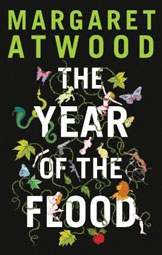A word of warning
The Year of the Flood by Margaret Atwood
 “We’re using up the Earth. It’s almost gone,” observes Toby, one of only two apparent survivors of the “waterless flood”, a virus that has spread with frightening speed to wipe out most of the human race. Hiding out in AnooYoo Spa, Toby fears that she is the only one alive, unaware that on the other side of the city, another woman has also survived, young Ren, trapped in nightclub Scales and Tails.
“We’re using up the Earth. It’s almost gone,” observes Toby, one of only two apparent survivors of the “waterless flood”, a virus that has spread with frightening speed to wipe out most of the human race. Hiding out in AnooYoo Spa, Toby fears that she is the only one alive, unaware that on the other side of the city, another woman has also survived, young Ren, trapped in nightclub Scales and Tails.
So begins Margaret Atwood’s latest novel, The Year of the Flood, a vivid depiction of a future that is all the more chilling for its nagging familiarity. Through Toby and Ren’s alternating flashbacks, we piece together what has brought them, and the rest of the human race, to this devastating place. Atwood takes us down dark streets patrolled by faceless security CorpSeMen and into thriving fastfood chain SecretBurger to show us the depths of this dislocated society. We learn of gene spliced animals like the liolam and the rakunk, byproducts of the powerful HelthWyzer Corp as they strive towards their goals of creating the perfect human and, of course, immortality. Irony – a cornerstone of Atwood’s writing – is strongly at play here, and the question of why anyone would want to live forever in such a world, is all the stronger for never being asked.
Against this backdrop, religious eco-cult the Gardeners provides a much needed antidote. Made up of Adams and Eves, the Gardeners are committed to a natural life where nothing is ever wasted and the souls of all living beings are respected. Toby and Ren are both ex-Gardeners and through their eyes Atwood shows us the core beliefs that bind the Gardeners together, while hinting at the uneasy shifts that will ultimately split them apart.
Creating the world of the Gardeners is where Atwood spends a lot of time, developing well rounded and vibrant characters, some of whom seasoned fans will recognise from her novel Oryx and Crake. She relives the Gardener’s many feastdays, explains their traditions and even transcribes their hymns in loving detail. There is humour present too in their jaunty sayings – “it is better to hope than to mope!” – and the reverse materialism that causes them to look down on those better dressed than themselves.
Adam One, the Gardener’s leader, may well be a mouthpiece for Atwood, delivering insight into the seeming inevitability of the earth’s destruction. ” ‘If you tell people there’s nothing they can do, they will do worse than nothing’,” he warns. A warning that is never heeded.
This warning, is at the core of the novel, and it is an important one. A pity then, that for this reviewer, the unrelenting focus on delivering it, was at times at the expense of the story. By lingering too long on details that back up her argument, Atwood sacrifices the beating heart of narrative we know she can deliver. And as The Year of the Flood drifts towards its conclusion, the story, like the world she depicts, is running on empty.
